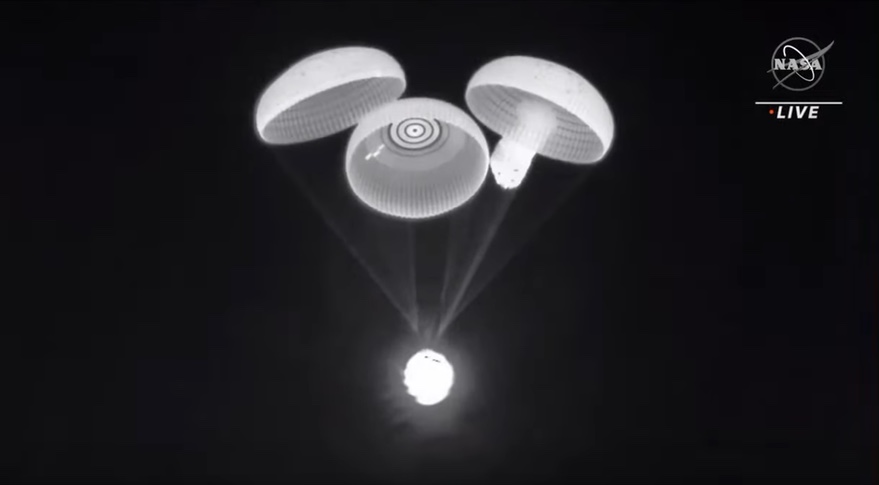WASHINGTON — NASA and SpaceX are investigating the delayed opening of a parachute on a cargo Dragon spacecraft that recently returned to Earth, an incident similar to one that took place on a Crew Dragon spacecraft last year.
NASA confirmed Feb. 2 that the cargo Dragon spacecraft that splashed down off the Florida coast Jan. 24, concluding the CRS-24 space station resupply mission, suffered a delayed opening of one of its four main parachutes but still allowed the capsule to safely land.
“During the return of the SpaceX CRS-24 mission, teams observed a single main parachute that lagged during inflation like the return of the Crew-2 mission,” agency spokesman Josh Finch said in a statement to SpaceNews. “The vertical descent rate of both flights was within the system design margins at splashdown, and all four main parachutes fully opened prior to splashdown on both missions.”
The Crew-2 Crew Dragon spacecraft, which splashed down Nov. 8, also had a parachute that was slow to open. NASA and SpaceX quickly cleared the Crew-3 mission to launch Nov. 10 after concluding that the parachute issue did not pose a safety risk.
Bill Gerstenmaier, vice president of build and flight reliability at SpaceX and a former head of human spaceflight at NASA, said at a Nov. 9 briefing that the delayed parachute opening was a “known condition” seen in some previous tests. “We don’t see anything that’s off-nominal that concerns us from a parachute standpoint,” he said then.
NASA and SpaceX are reviewing the parachute data ahead of the Crew-4 launch, scheduled for mid-April, and the subsequent return of the Crew-3 Crew Dragon spacecraft currently at the station. A commercial Crew Dragon flight to the International Space Station, Axiom Space’s Ax-1 mission, is scheduled for launch March 30, returning before the Crew-4 launch.
“As partners, NASA and SpaceX jointly review the imagery data and perform physical inspection of the drogue and main parachutes after flight. The inflation model also continues to be updated to better characterize and understand margins and splashdown conditions,” Finch said in the statement. “This review of flight data and parachute performance models will be completed prior to the launch of the Crew-4 mission and the return of Crew-3 astronauts from the International Space Station.”
NASA had not previously disclosed the parachute issue involving the CRS-24 mission, but one of the agency’s leaders hinted at it last week. “We’ve seen a couple of delayed parachute delays now on the fourth chute with cargo vehicles returning and one crew vehicle,” NASA Associate Administrator Bob Cabana said during a “safety stand-down” event at NASA Headquarters Jan. 27, the agency’s Day of Remembrance.
His comments were in response to a question about “normalization of deviance,” a concept where organizations ignore data that is out of normal bounds because it did not cause an immediate safety issue but which could post a longer-term hazard. Normalization of deviance was a factor in both the shuttle Challenger and Columbia accidents.
“We need to make sure we understand the model that we have, that we’re OK as we go forward,” Cabana said. “That’s going to require a little looking into and not just accepting that, well, it’s OK, nothing bad happened.”
Seeking more transparency
Unlike splashdowns of Crew Dragon craft, neither NASA nor SpaceX provide coverage of cargo Dragon spacecraft splashdowns. Those cargo Dragon splashdowns originally took place in the Pacific Ocean, hundreds of kilometers from the California coast, making coverage logistically difficult.
However, the lack of coverage continued even after cargo Dragon splashdowns moved to just off the Florida coast, the same location used for Crew Dragon splashdowns. NASA and SpaceX limited their coverage of the CRS-24 splashdown Jan. 24 to tweets and blog posts, without any photos or video. A NASA “Space to Ground” video about ISS activities, published Jan. 28, mentioned the splashdown but used file images from previous Dragon splashdowns.
Some NASA advisers have complained about a lack of public information about agency operations, including human spaceflight. Wayne Hale, chair of the NASA Advisory Council’s Human Exploration and Operations Committee, mentioned it during a Jan. 18 meeting of his committee.
“There is a real thirst out there for better understanding of what the agency is doing and, for some reason, the organization can’t seem to push that out the way we used to back in the shuttle days,” he said. “There seems to have been a marked decrease in the information flow. That bothers me a lot.”
